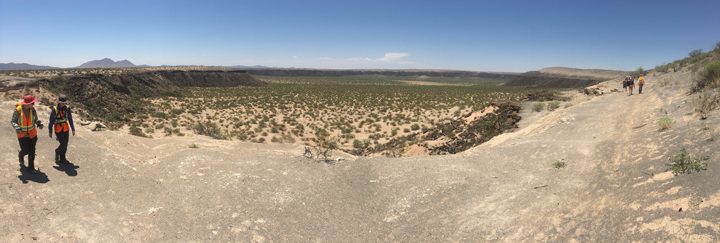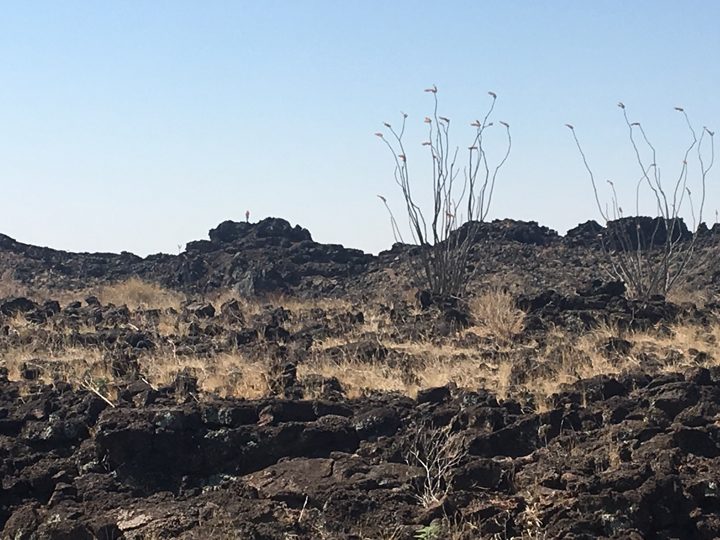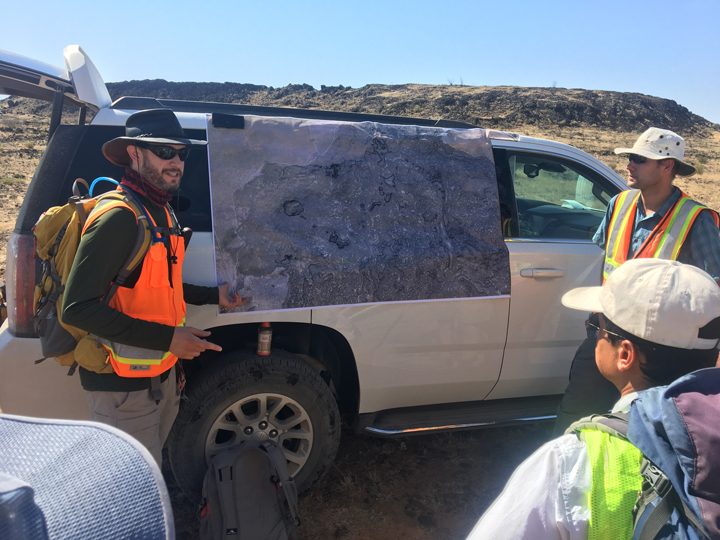Our first destination in Potrillo was Kilbourne Hole, a maar crater that was formed about 16,000 to 24,000 years ago. It’s an irregular hole measuring about 1-1/2 miles by 2 miles. Kilbourne is thought to be the result of a steam explosion that occurred when hot magma encountered shallow groundwater. The result was excavation of the crater and deposition of layered deposits that record the history of water here.

Panorama of Kilbourne Hole, with dark basalt visible in the crater walls. Courtesy of Ben Feist.
After a few days at Kilbourne Hole, we visited Aden Crater, where lava flows piled up to form a gently sloping volcano known as a low shield. As the lava continued to flow away, the summit collapsed, leaving a bowl-shaped depression called a caldera. The emplacement of lava flows at Aden led to a variety of other depressions, some of which are linked to lava tubes or underground caves, and some which are not. Understanding which pits will lead to caves is important because future explorers might use caves as shelter or as promising locations for scientific investigation. This was the main goal for our work at Aden Crater.
Team member Jose Hurtado of the University of Texas at El Paso explains how Kilbourne Hole formed and notes similarities to some features on Mars. NASA/GSFC
At Kilbourne Hole, the group looked for xenoliths, material that is brought up from deep in Earth’s mantle by volcanic activity and gets trapped inside other rocks. In this case, the xenolith is the greenish mineral olivine, which is sometimes used as a gemstone called peridot. NASA/GSFC
After a few days at Kilbourne Hole, we visited Aden Crater, where lava flows piled up to form a gently sloping volcano known as a low shield. As the lava continued to flow away, the summit collapsed, leaving a bowl-shaped depression called a caldera. The emplacement of lava flows at Aden led to a variety of other depressions, some of which are linked to lava tubes or underground caves, and some which are not. Understanding which pits will lead to caves is important because future explorers might use caves as shelter or as promising locations for scientific investigation. This was the main goal for our work at Aden Crater.

The terrain at Aden crater, a low shield volcano, is much different than Kilbourne Hole. Courtesy of Ben Feist

Team leader Jake Bleacher reviews the plan for the group’s first day at Aden crater. Courtesy of Ben Feist.
Jacob Richardson and Ben Feist check out a deep hole with cold air coming out, a welcome respite on a 104-degree day. A hot desert wind can be heard blowing. NASA/GSFC
Tags: geology, GIFT 2017, planetary analogs, solar system




Did u know… There is a nother vocano called aden crater in arab state is bigger than in newmaxcio